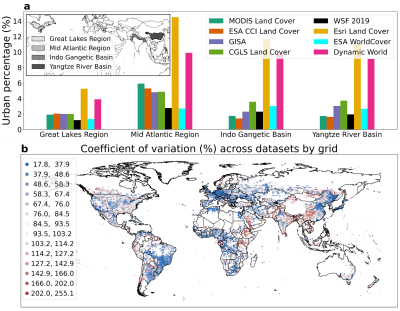Discrepancies in Urban Land Estimates Lead to Difficulties in Quantifying Climate Risks
New datasets delineating global urban land are now available after growth in computational power, methodological advancements, and an explosion in satellite observations in the last several years. While these products aim to support scientific research, application, and policy, in reality they can produce different results when applied to the same problem. This makes it difficult for researchers and policymakers to decide which dataset to use. This study compares several global urban datasets, assessing how discrepancies among them can impact various applications, from land cover projections to weather and climate modeling to quantification of urban environmental hazards.
Significant discrepancies in urban land area estimates due to differences in scale, definitions, and methodologies were found among the datasets analyzed in this study. These differences have implications for accurately monitoring urban climate hazards, simulating regional weather, and urban climate modeling. Researchers specifically illustrate the magnitude of impact that the choice of urban dataset can have via case studies. This included estimating urban heat and flood hazards. Newer datasets at higher resolution (~10 m) can partially resolve urban features like vegetation, roads, and settlements. However, the differences in the definition of ‘urban’ become prominent at these resolutions, leading to greater divergence between estimates of urban land in datasets for more recent years. This study calls for a sustained effort within the urban scientific community to evaluate and adopt suitable datasets for different research and policy applications.
The study highlights large disagreements in estimates of urban land across different global datasets. The datasets considered include satellite-derived land cover data, surface datasets used in weather and climate models, and future projections of urban land. This comparison underscores the need for using multiple datasets to provide more robust estimates of uncertainties for urban-resolving climate projections and better quantify hazards in a rapidly urbanizing world. For surface inputs to weather and climate models, it is suggested to choose land cover datasets that are consistent with the structural assumptions about urbanization in the corresponding models. Urban planners and policymakers are also encouraged to use region-specific maps rather than global datasets when possible, as these are better calibrated to local conditions. Since the preprocessing methods and urban definitions vary between datasets, the fit-for-purpose datasets for specific applications should be determined on a case-by-case basis with guidance from relevant domain experts. The study emphasizes the need for transparency about the underlying assumptions made when developing and using datasets to better inform policy and decision-making.

